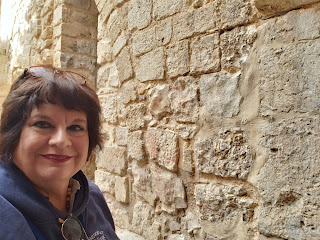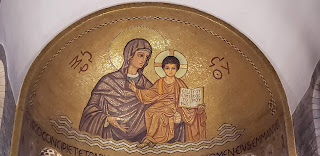on you guessed it, Mt. Zion, stands the Dormition Abbey.
| stock photo to orient the reader |

Tradition says that The Blessed Virgin Mary died near or at this site, which as with all sites, has had a number of holy edifices. In the fifth century it was Hagia Zion, of the Byzantines. In the twelfth century, the custodians were monks of the Abbey of Our Lady of Mount Zion. In the beginning of the 20th Century the Basilica that is there now was dedicated by the Latin Patriarch of Jerusalem.
It is also considered the likely location of the original Upper Room. What is there now is a room, but it is styled in the Gothic, so clearly not the actual room where the Apostles hid after Jesus' Crucifixion, and where Thomas put his hands into the wounds of the Resurrected Christ. I have always thought that if I could go back in time, the moment when Thomas says, "My Lord and My God" when he realizes that salvation history was fulfilled, would be the one I would choose. I must admit that this was one of the few places where I sensed little of the awesome Salvation history. Perhaps I lacked imagination. The room as currently constituted is empty. The whole compound is a bit of an amalgam. It is considered the possible location of the Dormition of Mary (which means that she fell asleep when she died and was raised to heaven thereafter; because she was without original sin, she her exit from life was a special one as befitted the Theotokos), because of the proximity of the Upper Room. But the Upper Room is also above the possible site of the Tomb of David. Naturally, as in all things related to the miraculous and earthly history of mankind, this is also in dispute. Apparently it takes quite a lot to get approval for a Mass to be celebrated in the room. Pope Francis, or Pope Benedict, did.
 |
| colonnade style of current upper room |
And just nearby, downstairs of the Upper Room, whether or not the site is actually that of the tomb of David (some say not; some say yes), it is a place reverenced by my Jewish cousins. This was one of the moments for me in which I felt a gratefulness for their relationship with God that makes my own possible.
 |
| No complaints please. There is a side for men and a side for women. |
And so, we pilgrims moved onto another locale where the ancient meets the modern.












No comments:
Post a Comment